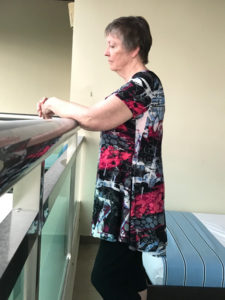 Our flight to Mexico was scheduled to leave early on the morning of January 2; we would drive to Cleveland on the afternoon of New Year’s Day to stay in a hotel near the airport. I had packed on New Year’s Eve.
Our flight to Mexico was scheduled to leave early on the morning of January 2; we would drive to Cleveland on the afternoon of New Year’s Day to stay in a hotel near the airport. I had packed on New Year’s Eve.  That meant I had the entire morning of New Year’s Day to sew one more top for Playa Maroma.
That meant I had the entire morning of New Year’s Day to sew one more top for Playa Maroma.
I dug into the stash and grabbed a poly knit I had picked up several years ago at Fabrix in San Francisco. It was not a “me” print, although I’m not sure the real “me” print exists. I’m ambivalent with prints. But it would easily slip on over a pair of black leggings and take me to one of the restaurants at the resort.
I had been wanting to make Butterick 5954 for myself for years. I had made it four years ago in a luscious purple velvet print for my younger grandchild. The pattern had sat in plain view ever since then, and everytime I got in the mood to make a new top for myself, I’d eye it and ask, “Now?”  And “now” finally arrived.
And “now” finally arrived.
Here’s my review:
Pattern Description: MISSES TUNIC: Close-fitting and flared, pullover tunic has front variations, shaped hemline and narrow hem. Wrong side shows on back hemline. C and D: collar.
Designed for lightweight Two-way Stretch Knits. I chose View A, with the short sleeves from View C. I’m normally not a short-sleeve gal, but I loved these sleeves and will use them again.
Pattern Sizing: Combinations: Y(XSmall-Small-Medium), ZZ(Large-XLarge-XXLarge) After adding 2″ to the length of the front and back, I cut a Large.
Did it look like the photo/drawing on the pattern envelope once you were done sewing with it? Y
Were the instructions easy to follow? I hardly used them.
What did you particularly like or dislike about the pattern? Liked everything. Disliked nothing!
Fabric Used: Some random poly print from Fabrix in San Francisco.
Pattern alterations or any design changes you made: I always add 2″ to the length on Butterick patterns. I’m 5’8″ and have a long torso.
As I haven’t blogged a top like this in a while, I’ll remind you that I always use a tricot interfacing cut the depth of the hems. Fuse it to the fabric edge, then fold and press for a clean hemline. Sew the side and underarm seams, then double-needle stitch the hems with wooly nylon in the bobbin. Love this method, that I learned from Marcy Tilton. No sloppy hems in my closet!! ☺ And I always interface the back shoulder seam allowance with a ½” or ⅝” strip of tricot interfacing to stabilize that seam.
See Liz’s comment and my response below. I couldn’t make the hyperlinks work in the comment, so here are resources for fusible tricot interfacing:
Pam Erny’s shop (Just noticed Pam’s site says the tricot will be restocked mid-February 2018.)
Pam’s blog
NY Fashion Center Fabrics
Would you sew it again? Would you recommend it to others? Yes and Yes.
Conclusion: Need a quick and easy make? This is it!!!



Love it! I will look into that hemming technique!
Thanks, Jill. I never had good hems with knits until I learned this technique.
I think I’m going to try this hem technique. I gave up on double needle hemming because it always tunneled so much, even if I used a stabilizer. As if the bobbin tension is just too high no matter how I change settings. Questions: where do you get the tricot interfacing? Local chain fabric store or online?
Also, I worry that using the machine bobbin winder will stretch out the wooly nylon, leaving no stretch when I actually use it on the hem. Do you hand wind the bobbin? (Seems like that would take a long time. ) Or do you just wind it on the bobbin the usual way on the machine?
Thanks! (I grew up just outside Cleveland but haven’t been back in twenty years.)
Nice shirt! Looks nice with the leggings.
Hi Liz,
Good questions. I’m sorry I forgot to include that important information.
Yes, I wind the bobbin by hand, but with assistance. I put the bobbin on the spindle, run the thread through the guide, then hold the spool in my hand and run the winder as slowly as I can. My objective is a smoothly wound bobbin while stretching the thread as little as possible. This seems to work the best for me. Some of Marcy’s other followers might have other ways to accomplish the same thing and I hope any who read this will add their comments. I keep a white and a black wooly nylon bobbin wound at all times.
Re the tricot interfacing, I purchase online.
I just discovered Pam Erny’s blog, off-the-cuff-style.blogspot.com and her store, fashiongsewingsupply.com, but I notice her fusible tricot is out of stock. I’ve emailed her to ask when it will be restocked and will post an update here when I learn the answer.
nyfashioncenterfabrics.com carries a Lightweight Fusible Tricot Interfacing (B1509) in white and black.
You can google “SOF Knit Interfacing,” which Marcy mentions in her “Easy Guide to Sewing Tops and T-Shirts, Skirts, and Pants,” co-written with Lynn McIntyre. There seem to be a lot of outlets for that.
Jo-Ann’s carries Pellon Easy-Knit. In a pinch, I’ve even cut a lightweight woven fusible on the bias when I was in a rush and had not planned ahead. 🙁
The other thing I didn’t mention in the post is that I use double-stitched seams. I had a serger for a while, but I was never truly comfortable with it, so gave it to my niece, who loves it. Yea! I stitch the 5/8” seam, then stitch a second seam in the seam allowance about 1/4” away from the first seam (for the shoulder, I stitch down the middle of the seam allowance so I have a generous 1/4” seam allowance remaining after trimming). Then I carefully trim the remaining seam allowance away from the second stitching. I press to the back on side and sleeve seams, or to one side on center seams. On the shoulder, I press to the back, then topstitch the seam allowance down a 1/4” away from the seam.
I’ll look forward to hearing what you think of the technique once you try it.